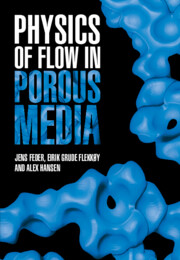Refine search
Actions for selected content:
5487 results in Thermal-fluids engineering
5 - Laminar Flow in Channels and Pipes
-
- Book:
- Physics of Flow in Porous Media
- Published online:
- 15 September 2022
- Print publication:
- 06 October 2022, pp 85-98
-
- Chapter
- Export citation
Index
-
- Book:
- Physics of Flow in Porous Media
- Published online:
- 15 September 2022
- Print publication:
- 06 October 2022, pp 344-348
-
- Chapter
- Export citation
13 - Particle Simulations of Multiphase Flows
-
- Book:
- Physics of Flow in Porous Media
- Published online:
- 15 September 2022
- Print publication:
- 06 October 2022, pp 290-328
-
- Chapter
- Export citation
7 - The Darcy Law
-
- Book:
- Physics of Flow in Porous Media
- Published online:
- 15 September 2022
- Print publication:
- 06 October 2022, pp 127-156
-
- Chapter
- Export citation
6 - The Hydrodynamic Equations
-
- Book:
- Physics of Flow in Porous Media
- Published online:
- 15 September 2022
- Print publication:
- 06 October 2022, pp 99-126
-
- Chapter
- Export citation
9 - Capillary Action
-
- Book:
- Physics of Flow in Porous Media
- Published online:
- 15 September 2022
- Print publication:
- 06 October 2022, pp 187-215
-
- Chapter
- Export citation
Frontmatter
-
- Book:
- Physics of Flow in Porous Media
- Published online:
- 15 September 2022
- Print publication:
- 06 October 2022, pp i-iv
-
- Chapter
- Export citation

Physics of Flow in Porous Media
-
- Published online:
- 15 September 2022
- Print publication:
- 06 October 2022
10 - Steady State Problems
-
- Book:
- Computational Aerodynamics
- Published online:
- 12 August 2022
- Print publication:
- 01 September 2022, pp 330-366
-
- Chapter
- Export citation
Acknowledgments
-
- Book:
- Computational Aerodynamics
- Published online:
- 12 August 2022
- Print publication:
- 01 September 2022, pp xvii-xviii
-
- Chapter
- Export citation
Appendix F - Turbulence Models
-
- Book:
- Computational Aerodynamics
- Published online:
- 12 August 2022
- Print publication:
- 01 September 2022, pp 583-588
-
- Chapter
- Export citation
Dedication
-
- Book:
- Computational Aerodynamics
- Published online:
- 12 August 2022
- Print publication:
- 01 September 2022, pp vii-viii
-
- Chapter
- Export citation
2 - Mathematical Models of Fluid Flow
-
- Book:
- Computational Aerodynamics
- Published online:
- 12 August 2022
- Print publication:
- 01 September 2022, pp 10-41
-
- Chapter
- Export citation
Preface
-
- Book:
- Computational Aerodynamics
- Published online:
- 12 August 2022
- Print publication:
- 01 September 2022, pp xv-xvi
-
- Chapter
- Export citation
Appendix C - Polynomial Interpolation, Differentiation, and Integration
-
- Book:
- Computational Aerodynamics
- Published online:
- 12 August 2022
- Print publication:
- 01 September 2022, pp 527-543
-
- Chapter
- Export citation
Appendix A - Vector and Function Spaces
-
- Book:
- Computational Aerodynamics
- Published online:
- 12 August 2022
- Print publication:
- 01 September 2022, pp 496-507
-
- Chapter
- Export citation
Appendix D - Potential Flow Methods
-
- Book:
- Computational Aerodynamics
- Published online:
- 12 August 2022
- Print publication:
- 01 September 2022, pp 544-563
-
- Chapter
- Export citation
Contents
-
- Book:
- Computational Aerodynamics
- Published online:
- 12 August 2022
- Print publication:
- 01 September 2022, pp ix-xiv
-
- Chapter
- Export citation
Appendix B - Approximation Theory
-
- Book:
- Computational Aerodynamics
- Published online:
- 12 August 2022
- Print publication:
- 01 September 2022, pp 508-526
-
- Chapter
- Export citation
3 - Numerical Methods for the Solution of Partial Differential Equations
-
- Book:
- Computational Aerodynamics
- Published online:
- 12 August 2022
- Print publication:
- 01 September 2022, pp 42-96
-
- Chapter
- Export citation
